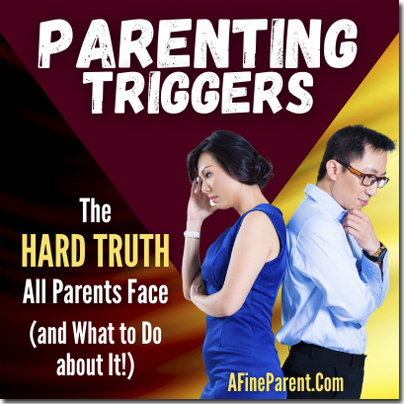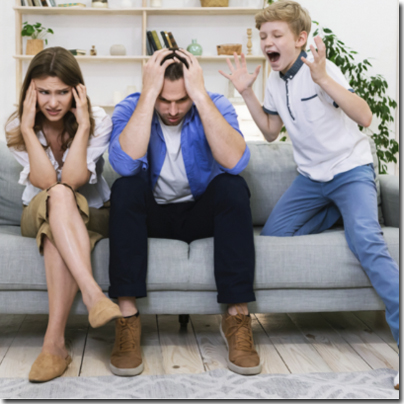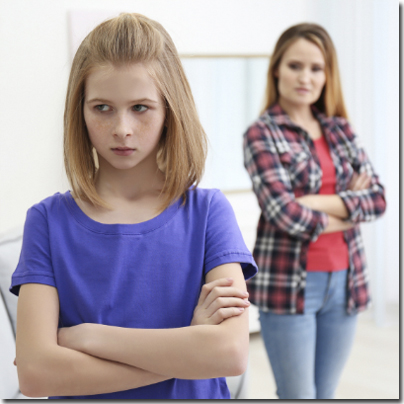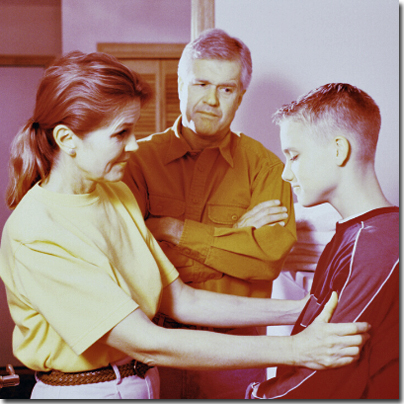 “No.”
“No.”
I locked eyes with the deep blue irises of my son as he glared at me through his long lashes. While his eyes remained stubborn, I could see the small upward turn of his mouth. He was trying to hide it but the dimple on his cheek gave him away; he knew he was going to get me with that one word.
“No.”
We’ve been down this road before. Setting up the day with lots of praise when I catch him doing something positive and a reinforcement system that involves his coveted iPad will often work beautifully.
But…
After a week of long days at school (where he has to work harder than most to dial in his impulses), sports activities, and just not as much time for the direct attention from his mama that he reaped during the year and a half of quarantine, these moments seem unavoidable at times.
My usually sweet and affectionate blonde-haired babe will suddenly reenact a Jekyll and Hyde performance that will leave my mind spinning long after he’s over it and moved on. It’ll usually begin small enough: a pouting face or a tear, easy enough to handle. But if the usual tactics don’t work, I’ll suddenly find myself in a face-off with a 35 pound bulldog. In those moments, it won’t matter if I’m asking him to recite the Declaration of Independence or eat an ice cream cone; the answer will always be a vehement “NO.”
These moments leave me feeling like the sole purpose of his life is to get under my skin. I’m quite certain he knows what he needs to do, may even want to do it–yet refuses because he knows it is what I want him to do…and if he’s annoyed, he sure as heck wants to make sure I am too.
I can feel my blood pressure rise, my hands start to sweat, and I have the sudden urge to yell. As a behavior specialist by profession, the editor of a positive parenting site by passion and a mom constantly working on personal growth, I can keep it together a lot of the time. But that “no” is my Achilles heel. In those moments, “no,” is a parenting trigger that I struggle with.
A trigger, according to psychologist, parenting expert, and author of Peaceful Parent, Happy Kids, Dr. Laura Markham, is “anything you experience in the present moment that activates a feeling from the past.” Triggers are dangerous because they can elicit a feeling that in turn causes us to react in a way that’s not keeping with the present.
How Do We Know What Our Parenting Triggers Are?
 Take a minute to answer these questions (honestly):
Take a minute to answer these questions (honestly):
- Do I ever find myself excessively angry at my kids to the point in which there is a physiological reaction (sweaty hands, red-face, or yelling)?
- Do I ever find myself excessively sad, hurt, or upset by my child’s behavior, even to the point in which I find myself crying?
- Do I ever reflect on a situation after it’s over and realize that the level in which I was angry, sad, or hurt was disproportionate to the situation and behavior?
- Do I ever feel completely out of control of my behavior or reactions?
- Do these feelings seem familiar, like I’ve experienced them before or often?
- Do these feelings sometimes seem to come out of nowhere, suddenly and unexpectedly?
- Do I ever have the urge to spank, slap, or otherwise physically hurt my child (even though in a rational state of mind, I am staunchly against corporal punishment)?
If you answered “yes” to any of these questions, you have likely been triggered.
Now think about the particular behaviors that come to mind as you answered “yes” to any of the above questions. What is the behavior? Most parents will find that the triggering behavior falls under one of these behaviors:
- Crying
- Whining
- Tantrums
- Disobeying
- Disrespect
- Sibling fights
- Loud/incessant talking
- Clinginess (especially if you are touched out)
So you know that you have a parenting trigger and hopefully have it narrowed down to one (or more!) specific behavior (either from the list above or something else entirely) as the culprit. Now what?
Psychologist and psychoanalyst Peter Fonagy stresses the importance of parental ability to self-reflect through his research in Reflective Functioning within parent-child relationships. Fonagy researched the ability of parents to be a “reflective parent;” the ability to consider what is going on in the child’s mind as well as to be aware of their own thoughts and feelings. Fonagy’s research has found that parents who have “high reflective functioning” have children who are more securely attached, have better social skills, a better ability to “read” others and an increased ability to regulate emotions in high-stress situations.
Most of the time, triggers activate old wounds from childhood: situations that may have elicited emotions while we were kids. Those visceral feelings affect our mood and make it hard for us to connect to our children in the moments that they really need us.
Parents who take the time to self-reflect on what situations from the past may be triggered during current situations are better able to handle parenting challenges, tough situations, and trigger-inducing moments in ways that best suit their child’s needs.
So let’s do some self-reflection! Take a glance back at the behaviors you recognized as being triggers for you and read ahead to find out more about why they may be your parenting triggers.
Why Am I Seeing Red? Uncover the Situational Triggers From Childhood
 It likely comes as no surprise that the past can affect the future; but with the fast-paced life in the age of social media, high-tech electronics, full-time jobs, and a million other factors to keep us busy, we may find it difficult to find time to really think about how situational triggers from childhood may have evolved into parenting triggers. Take a look at some possible situational triggers that could be leading our responses:
It likely comes as no surprise that the past can affect the future; but with the fast-paced life in the age of social media, high-tech electronics, full-time jobs, and a million other factors to keep us busy, we may find it difficult to find time to really think about how situational triggers from childhood may have evolved into parenting triggers. Take a look at some possible situational triggers that could be leading our responses:
Automatic Fight or Flight
If we find ourselves often feeling like our child is the enemy when they get upset (and yelling as a result), it may be because our parents reacted harshly when we got upset and we learned, as a result, that those situations were “emergencies” and warranted a fight or flight response.
 Do you find yourself “losing it” and yelling at your kids often? Sheila McCraith, a stay-at-home mom of 4 boys, a former yeller, and author of “Yell Less, Love More,” shares her experience of going 520 days straight without yelling and lots of great tips that helped her make it happen in our “Stop Yelling at Kids” masterclass.
Do you find yourself “losing it” and yelling at your kids often? Sheila McCraith, a stay-at-home mom of 4 boys, a former yeller, and author of “Yell Less, Love More,” shares her experience of going 520 days straight without yelling and lots of great tips that helped her make it happen in our “Stop Yelling at Kids” masterclass.This packed masterclass is one of the 70+ masterclasses you get when you join the AFineParent Academy today. Click here to learn more.
Helpless or Frustrated
If we find ourselves often feeling helpless, powerless or frustrated when our child is upset, it may be because we were neglected, ignored, or sent to our bedrooms as a child to figure out our feelings by ourselves. If big emotions were never comforted by an adult when we were a child, we may have never developed a mental model of how to comfort those emotions in our own children- leaving us feeling helpless.
Confronted or Challenged
If we find ourselves often feeling confronted, challenged, or in the throes of a power struggle before we can even blink, it may be because we were not allowed to disobey as a child without being harshly punished, making it difficult to tolerate refusal or noncompliance in our own children.
Insecure & Anxious
If we find ourselves often feeling insecure or anxious as a result of our child’s tantrums or displays of big emotions, it may be because big emotions were not tolerated in our childhood. If crying was forbidden or anger was never allowed to be expressed without being ignored or mocked, we may experience feelings of anxiety when we witness our children trying to cope with big emotions.
Disrespected & Angry
If we find ourselves often feeling disrespected and hurt by our child’s behavior, it may be because we were not given respect as a child. When we are triggered, a playback of childhood may cause us to overly perceive behaviors as disrespectful–even when they come from a toddler.
Self-Critical
If we find that our child’s behaviors lead to self-criticism about our parenting abilities, it is likely because we concluded as a child that we were never good enough. Perfectionism can not only sabotage our own self-worth, but can interfere with our ability to provide unconditional love to our children as they can easily sense if we don’t accept them the way they are.
Protective
If we find ourselves often feeling overly protective of our children when they have social difficulties, it may be because we were bullied or socially ostracized as a child. The emotions that may resurface from our childhood can make it difficult to constructively help our child navigate through social difficulties.
What parts of your childhood may be contributing to your current parenting triggers? When we are better able to recognize our triggers before they happen, we will often find ourselves more easily able to avoid reacting when they do arise.
Before moving onto this next section, take a minute to reflect on what might be contributing to your personal parenting triggers. You may want to journal or talk about them with your partner or a trusted friend. If parenting triggers often feel too big to handle or you find yourself being easily emotionally triggered, it may be beneficial to process more regularly with a therapist.
How to Handle Your Parenting Triggers
 I hate sitting in traffic. It makes me annoyed and irritable; when I can avoid roads or times in which I know traffic will be bad, I will. However, I can’t always delay a drive and sometimes there is only one road I can take. I have found that if I am able to check out drive times on my GPS to give myself a quick reminder that I will have to sit in traffic, the emotions that I experience when it happens are less intense and I have more patience.
I hate sitting in traffic. It makes me annoyed and irritable; when I can avoid roads or times in which I know traffic will be bad, I will. However, I can’t always delay a drive and sometimes there is only one road I can take. I have found that if I am able to check out drive times on my GPS to give myself a quick reminder that I will have to sit in traffic, the emotions that I experience when it happens are less intense and I have more patience.
Much like knowing the traffic to expect helps me better prepare for handling it, knowing what our triggers are and why they are triggers can help us better handle them when they happen. But it doesn’t end there. What else can we do about our parenting triggers?
Take Care of Unmet Needs
 Our parenting triggers can often be a reminder that we have unmet needs. We know that we cannot take care of our family the way we want unless we first take care of ourselves- but boy, can that be hard to follow through on!
Our parenting triggers can often be a reminder that we have unmet needs. We know that we cannot take care of our family the way we want unless we first take care of ourselves- but boy, can that be hard to follow through on!
Taking care of unmet needs may mean tag-teaming with our partner or support system to create a family culture in which responsibilities are shared. It may also mean identifying what type of self-care is important to our well-being and to feeling centered on any given day. Self-care can even mean that we learn to say “no” to things we don’t want to do. Self-care can look different for different parents, but the benefits we reap when we take care of unmet needs are undeniable. Some self-care you may want to consider if you aren’t already doing them include:
- Exercising regularly
- Eating healthy
- Daily meditation
- Daily journaling
- Deep breathing exercises (read ahead to the next section for more on this)
- Setting limits and saying “no” to others
- Tag-teaming with your parenting support group
- Finding time to connect to nature
- Find time to be alone
- Go for a walk
Here is our full list of 100 self-care ideas that are easy to fit in a busy schedule!
Stop & Take a Breath
 What are the physical signs you feel when you are experiencing a parenting trigger? Sweaty palms, flushed face, and a racing heart rate could all be physiological systems of a trigger. When we feel these signs happening we can choose to pause and take a deep breath before we move on.
What are the physical signs you feel when you are experiencing a parenting trigger? Sweaty palms, flushed face, and a racing heart rate could all be physiological systems of a trigger. When we feel these signs happening we can choose to pause and take a deep breath before we move on.
I know, I know… “take a breath” has become such a cliche that you may want to roll your eyes when I say it; but there are neurological reasons why breathing helps. The physiological systems we experience when we are triggered are the involuntary actions controlled by our autonomic nervous system.
One half of that system (the sympathetic nervous system) controls our fight-or-flight response, while the other half (the parasympathetic nervous system) controls our rest-and-relax response.
While it’s impossible to eliminate activity from these systems completely, deep breathing can help quiet our sympathetic nervous system, leading to a reduction of those physiological systems.
While this may feel difficult at first, the more we practice deep breathing, the easier it will become. Engaging in breathing exercises while we are in a calm and predictable space is essential in being able to transfer skills to triggering situations. It may be helpful to play around with different breathing exercises to see what works best. To get started, try out these deep breathing exercises:
- Alternate nostril breathing: using your thumb, alternately close off the right and then left nostril while taking deep inhales and exhales.
- Belly breathing: standing, sitting, or laying, place a hand on the belly and breath with a focus of moving the belly toward the spine and then back outward.
- Box breathing: exhaling, holding the breath out, inhaling, and then holding the air in with all steps on a count of four.
- Pursed-lip breathing: inhale slowly through the nose for two seconds and then exhale through pursed lips for four seconds.
Don’t Respond…Until You’re Calm

If we feel the need to set our child straight while in the middle of a situation, it is likely that we are being triggered. Setting limits while in an escalated emotional state holds the risk that we will set limits that are not enforceable or reasonable for our children. Rather than allowing our child to look like the enemy, we can choose to take a “parent time out” until we can calmly return to the situation and set a limit with the right mindset.
How can we best do this? Refer back to the tip prior and take a breath! Once we ensure that safety is not an issue, we can give our child a quick verbal statement such as, “We will figure this out once I’m calmed down.” Once self-control is regained, we can then process the incident with our child and set limits with a stable mindset.
Some tips for setting positive limits include:
- Be specific and use less words. Even older children benefit from less verbiage when it comes to making sure that limits are clear and leave no room for misinterpretation.
- Remind your child that behavior is a choice–and so are consequences. It can be helpful to use statements such as, “If you choose ____, then you can ____. If you choose ____, then you cannot ____,” making sure to give them both the positive and negative behavior and the correlating consequences.
- Be consistent and follow through!
- Avoid power struggles. Just restate the limit rather than engaging in arguments.
Switch Your Focus of Control
 How often do we notice that when we respond to our child’s anger with our own, the situation quickly escalates and we find ourselves in a shouting match?
How often do we notice that when we respond to our child’s anger with our own, the situation quickly escalates and we find ourselves in a shouting match?
Situationism is the view that our behaviors and attitudes are determined by our surroundings and immediate environment, while dispositionism is the theory that our behavior is determined by internal factors. While subfields of psychology tend to focus on one or the other, it is likely that our behavior is a product of both internal drive and external influence.
I think that all parents can agree that although it would be easier to have the mind-control ability of Jean Grey while our child is in the throes of a tantrum, we are sadly not X-Men. The only person we have control of in those moments is…ourselves! And while anger may be a natural response to defiance, it is not a shoe-in that a display of anger will change the behavior of our child and even less likely it will change it for the better.
Switching our focus of control to ourselves not only allows us to react in a way that we can reflect on later without feelings of shame, but also gives us a better chance to positively influence our child’s behavior. Crisis Prevention Institute’s Integrated Experience illustrates how behavior influences behavior in an endless cycle. When we react negatively to our child’s behavior, we likely notice they will follow suit; however, we have the power to turn our behavioral influence into an asset instead of a liability! To do so, we can:
- Be mindful of personal space and body language. Even when we are frustrated, we can keep our facial expressions and movements respectful and nonthreatening.
- Be mindful that how we say things are more impactful than the actual words we use. Cadence (rate of speech), tone (attitude of speech), and volume (loudness of speech) all provide our children with paraverbal cues that can be either positive or negative.
Wrapping It All Up…

Through a LOT of trial and error, I have learned that when my son says “no,” and I feel the signs that I have been triggered, the best I can do for both of us is to clearly repeat what I need him to do and then turn away.
After turning away, I take some deep breaths while making the statement to myself, “this is temporary.” Having this plan for when I am triggered has helped in a few ways:
- It gives my son access to the direction without a yelling, red-faced mom attached
- It gives us both space to keep in control of our behavior (with the secondary benefit that most often when he no longer has my undivided attention, he is usually more likely to do what he was asked to do)
- It gives me access to a go-to statement that helps me reframe my thoughts
- It allows for decreased stress that comes with simply knowing there is a plan!
Taking the time to identify your parenting triggers is the first step to stopping them from interfering with your amazing ability to be a presence of calm for your child when they are feeling big emotions. You’ve got this!
The 2-Minute Action Plan for Fine Parents
The first step toward creating a plan for triggers is to identify them! If you have not done so already, ask yourself the following questions to determine if you’ve been triggered. As you are answering, think about (and write down) the specific situation or behavior that comes to mind as you answer “yes”:
- Do I ever find myself excessively angry at my kids to the point in which there is a physiological reaction (sweaty hands, red-faced, or yelling)?
- Do I ever find myself excessively sad, hurt, or upset by my child’s behavior, even to the point in which I find myself crying?
- Do I ever reflect on a situation after it’s over and realize that the level in which I was angry, sad, or hurt was disproportionate to the situation and behavior?
- Do I ever feel completely out of control of my behavior or reactions?
- Do these feelings seem familiar, like I’ve experienced them before or often?
- Do these feelings sometimes seem to come out of nowhere, suddenly and unexpectedly?
- Do I ever have the urge to spank, slap, or otherwise physically hurt my child?
The Ongoing Action Plan for Fine Parents
Now that you have identified your parenting triggers, they can no longer blind-side you in the moment! The next time that you feel yourself being triggered, take note of the difference you may feel simply from having self-recognition. Moving forward, make a plan of action for trigger moments, which may include these important parts:
- A verbal plan for relaying information to your child in the moment without a power struggle (think about how you can communicate calm through nonverbal and paraverbal cues). This can include an acknowledgement statement to your child such as “We can talk when I calm down.”
- A physical plan to turn away or walk away to allow for space
- A breathing plan that will allow you to benefit from mindfulness
- A mental plan such as a reframing statement that you can say to yourself
- A restorative plan for how to process what happened afterwards and a plan for how to set future limits clearly.
Leave a Reply